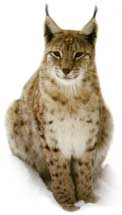



Historical distribution and present status of the lynx
(Lynx lynx) in Greece
Past and present status and distribution
The lynx has been widespread, but quite rare in Greece during the 19th century and the beginning of the 20th. During that period, lynx distribution expanded from Thrace south to the Peloponnese. The scientific mission of Morias (Peloponnese) which took place in the last decades of the 19th century reported lynx distribution in the Peloponnese on several mountains. However, the lynx was more common and widespread on the mountains of southern and northern Pindos and on the mountains of Macedonia and Thrace: Mt. Vitsi, Mt. Varnoundas, Mt. Voras and Rhodope Mts. Regular sightings date back 40–45 years in the plain of Vistonida Lake (Thrace) and the Nestos Delta “Kotza Orman” Forest, until the large-scale deforestation of the alluvial plain, in the early 1950s.
Over the last 40 years, there has been a dramatic reduction in the original distribution of the lynx. In 1991–1993, a National Inventory of Fauna and Flora, collected recent data of lynx presence in Greece. Today, there are scarce reports of observations from N. Pindos and Voras Mts. The last reports of sightings and/or damage in the Evros Mts. and the region of Thrace date back 35–40 years. However, the present status of the lynx in Greece remains uncertain.
Northern Pindos Mts. Is an area of extensive mixed and coniferous forests with scattered human settlements, which covers almost 1000 km2. In general, the people interviewed knew very little about the lynx and the older people had only a faint idea of the species' appearance and behavior. There were three reported sightings and a case of livestock damage. Re-colonization from Albania is a faint possibility, as the animal has been absent in the area during the last 20 years.
In the mountains of Evros (Thrace), villagers are more familiar with the lynx, where the species has the local name “sari gutzuk” (sari = reddish, gutzuk = short tailed). The shepherds reported that the lynx was already rare during the period 1950–1960. Local people are familiar with the cry of the lynx and shepherds believe that the lynx were frightening away the wolves, which were responsible for the killing of numerous sheep and goats. The lynx was attacking too, but in a different manner, killing one or two animals at a time on a regular basis. The last two lynx in the Evros region were sighted by local shepherds at the end of the 1960s.
The region of Central and Western Rhodhope Mts. is a large, undisturbed forested area covering more than 2000 km2. Most of the villages within this mountain range are now abandoned. During the last 35 years and after the abandonment of traditional livestock raising practices, the area has been naturally reforested with dense forests of spruce, beech and pine. Although the Rhodope Mts. have some ideal characteristics as lynx habitat (good roe deer numbers, extensive forest coverage, very low disturbance), the linkage with the Pindos Mts. and other forested areas to the west is problematic, since large intensively cultivated plains interfere. Moreover, the lynx is extinct in the north (Bulgarian Rhodope Mts.) and the east (European Turkey). Thus, it has been quite impossible for the lynx to re-colonise the area after its extinction.
Mt. Voras or Kaimaktchalan is the third highest mountain in Greece and together with Mts. Tzena and Pinovo they form a continuously forested mountain range along the border with FYROM. The region has recently been recolonised by bears, originating from the neighboring mountains of FYROM. In the mid-90s, there were two unconfirmed lynx sightings in the area.
The alluvial plain of River Nestos holds today the largest riverine forest in Greece and one of the largest in the Balkans, the “Kotza Orman”. Today, a significant part of the forest has been restored to its natural status and the restoration project is still continuing. The population of jackals is increasing, and a new population of wild boar has been established. The area hosts the only autochthonous wild pheasant population in Europe. During 1998-99, three lynx sightings have been reported in the area.
For the most recent data on the distribution of large carnivores in Europe you can visit the website of EU, where you can find in pdf format the brochure of IEA/LCIE, for the research of which Callisto has also contributed.
You can also visit the official online database for the status of the 5 carnivore species in Europe and the Balkans, which comprises the result of IEA/LCIE project, in which Callisto had the responsibility for the Balkans.
